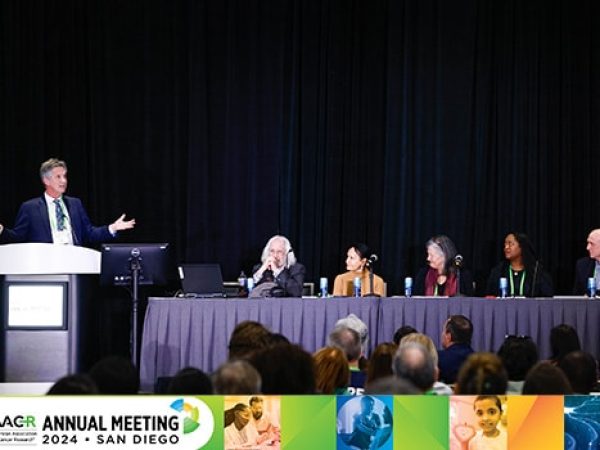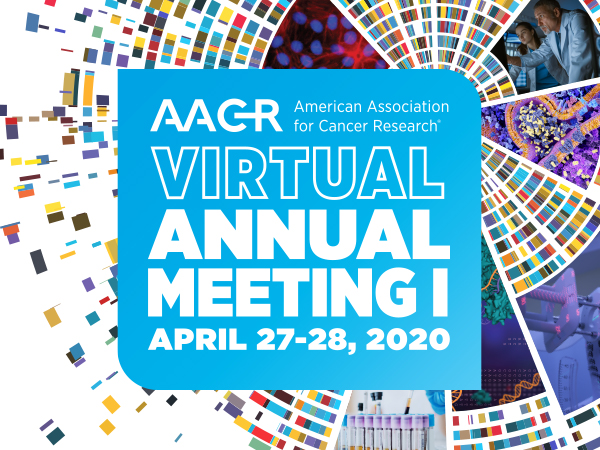NCI Director Introduces New Era of Cancer Research
Like Taylor Swift’s Eras Tour, Kimryn Rathmell, MD, PhD, began her tenure as the director of the National Cancer Institute (NCI) in December 2023 following a “Cruel Summer” that saw Congress pass legislation to raise the debt ceiling but cut funding for scientific research—among other things—and put a freeze on increases until after 2025. Despite that challenge, Rathmell is “…Ready for It,” taking a position she could only imagine in her “Wildest Dreams”; prepared to help other physician-scientists overcome obstacles she knows “All Too Well (Two Decades Version)”; excited to explore the “Blank Space[s]” that currently exist between different fields of research, science, and government bodies; and dedicated to achieving the NCI’s goal of helping patients with cancer “Long Live.”
But “Don’t Blame Me” for all of the Swift references. Rathmell herself kicked off her address at the American Association for Cancer Research (AACR) Annual Meeting 2024 on April 8th with an image of multiple colored boxes that she asked audiences if they recognized. Naturally, it was the backdrop of the Eras Tour poster with Swift’s images removed. Why? Well, Rathmell is from Nashville, so of course she is a fan. But she also believes cancer research is entering a new era that will require researchers to think a little differently. So, she wanted attendees to experience a talk that was a little different from what you might expect from the NCI director.
The Spaces In Between
To encourage attendees to think beyond the whole picture and see the “spaces in between,” she showed a Rorschach inkblot and a Magic Eye image created for the National Institutes of Health (NIH). The point was that magic can be found between the edges of two things that might not seem like they connect or even among areas we often overlook.
When it comes to cancer research, Rathmell mentioned how this applies to the new spaces artificial intelligence (AI) is opening for scientists, the fact that researchers are uncovering the ways the microbiome influences our health, how genome scientists are now exploring the noncoding regions of the genome, and the new perspectives community-based participatory research can offer to scientists.
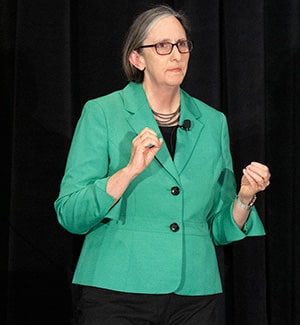
Rathmell said that breaking down barriers to work across various areas of science is what will define the next era of cancer research. She said the previous “traditional” era involved top-down research and care in which researchers focused on their own specialized work. Meanwhile, the “current” era from the past decade or so involved a horizontal approach with the rise of team science, interdisciplinary research, and new technology and data capabilities.
“Our next era…would be better defined as 360˚,” she explained. “Truly cross-sector collaborations, better engagement, not just sharing of our knowledge but including and learning from our knowledge to create something that is new,” she said.
“This is thinking in the spaces on steroids and is becoming the norm.”
This will include looking for ideas outside of a scientist’s normal research zone, whether that is from scientists in different fields, patients (especially those within underserved populations), or even government agencies not in health care. In fact, the reignited Cancer Moonshot, which President Biden announced in February 2022, included the formation of the Cancer Cabinet that brings together representatives from more than 20 government agencies such as the NCI and NIH as well as the Department of Energy, Department of Agriculture, Department of Labor, Environmental Protection Agency, the National Aeronautics and Space Administration, and others.
“The approach of putting everyone at the same table and really ensuring that all of government is working together—that’s actually a major culture shift and is working remarkably well,” Rathmell said. “And so that’s going to be a big part of how we move into really reaching every patient and being able to say that cancer is a different kind of disease.”
Reigniting the Cancer Moonshot
A commentary published in Cancer Discovery, a journal of the AACR, by Catharine G. Young, PhD, assistant director for Cancer Moonshot Policy, and Danielle M. Carnival, PhD, deputy assistant to the president for the Cancer Moonshot, detailed some of the progress the Cancer Moonshot has made in the past two years since President Biden’s announcement to reignite the mission he initially established as vice president in 2016.
Among the achievements are:
- The Self-collection for HPV testing to Improve Cervical Cancer Prevention (SHIP) Trial, which was launched by the NCI Cervical Cancer “Last Mile” Initiative to test the effectiveness of self-screening methods for cervical cancer.
- SmokeFreeNative, an initiative from NCI and the Indian Health Service that uses text messages to encourage American Indians and Alaska Natives to quit smoking while still recognizing the significance of traditional tobacco in their cultures.
- The Advanced Research Projects Agency for Health (ARPA-H), which has already awarded more than $500 million to researchers for projects that include new ways to prevent cancer, visualize cancer cells during surgery, and treat cancer through the use of bacteria.
- The Cancer Moonshot Scholars, an early-career program within the NCI that invests in growing the next generation of cancer researchers.
- New reimbursement codes established by the Centers for Medicare and Medicaid Services for patient Principal Illness Navigation services to remove barriers that prevent some patients from receiving these services that can help them better understand their options.
During another session at the AACR Annual Meeting 2024, “The Cancer Moonshot: Opportunities to Fulfill the Vision of the National Cancer Plan,” Rathmell compared the original Cancer Moonshot funded under the 21st Century Cures Act as the launchpad and the reignited Cancer Moonshot to a rocket in which they take what they learned and focus on making a difference in patient care. The mandate delivered by President Biden is to reduce mortality from cancer by 50% by 2047 and to “end cancer as we know it.”
“The government can’t do this alone, academia can’t do this alone, and industry can’t do this alone,” Elizabeth M. Jaffee, MD, FAACR, deputy director of the Sidney Kimmel Comprehensive Cancer Center at Johns Hopkins and chair of the President’s Cancer Panel, said during the panel. “This is a time when we’ve made so much progress, so many discoveries. But we can’t stop funding now. This would be the worst time to stop funding this amazing progress that we’re seeing.”
What About the Budget?
Concerns over cancer research funding were expressed by multiple members of the panel, which also included AACR President Patricia M. LoRusso, DO, PhD (hc), FAACR, of the Yale Cancer Center and Bianca N. Islam, MD, PhD, of Case Western Reserve University School of Medicine. Plus, Rathmell fielded several questions about the NCI budget following her address.
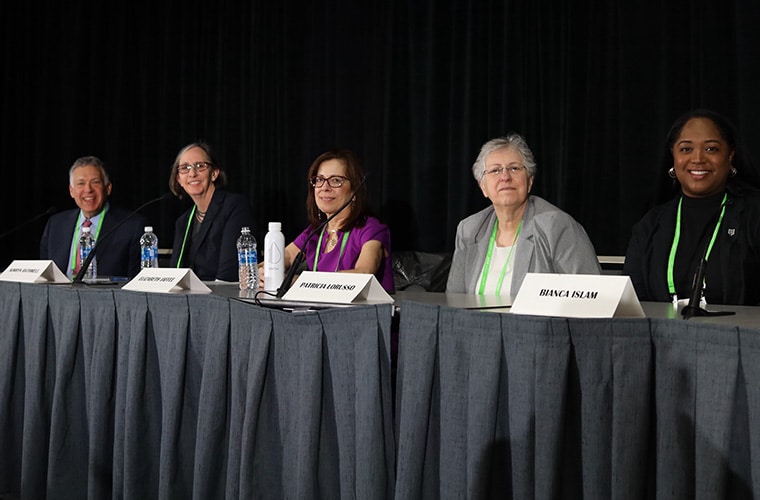
Ultimately, the NCI will be operating with $96 million less in 2024. While Congress granted an additional $120 million over what was in the NCI’s base budget for the previous fiscal year, 2023 marked the final year the NCI received funding—$216 million—for the Cancer Moonshot under the 21st Century Cures Act. For 2025, at most the budget can only increase by 1% under the debt ceiling legislation passed in June 2023, which Rathmell acknowledged won’t even cover general cost of living increases.
“I always thought if I were just the NCI director, I would fix it all, and it turns out it’s hard,” Rathmell said. For now, she expressed the importance of ensuring early-stage investigators can get R01 research grants. For the fiscal year 2024, NCI will fund the top 17% of R01 applications from early-stage investigators compared to 10% for more established and new researchers. “I really believe that we need our early-stage investigators getting on with their R01s and bringing their great ideas to life and we can’t have a period of time where that gap happens.”
Rathmell was also glad they were able to keep cancer centers whole, which should help support investigators at NCI-designated cancer centers but acknowledged it will still be a tight squeeze. “We’re essentially flat and it’s feeling like it’s less because it costs more to do everything every day,” she added.
For those concerned about the loss of funding, many of the panelists encouraged attendees to reach out to their legislators. For example, Islam mentioned how young researchers could become involved with the AACR’s Early-career Hill Day in which researchers visit the Capitol to lobby for government support.
“One of the things that I’ve learned during my time at the Hill with my colleagues is when you go into these offices, everyone is human,” Islam said. “And our stories make us human. So you need to learn how to share those personal stories.”
The National Cancer Plan
No matter the budget, Rathmell is dedicated to fulfilling the goals of the reignited Cancer Moonshot and the National Cancer Plan, which was devised under former NCI Director and current NIH Director Monica Bertagnolli, MD. In a commentary published in Cancer Discovery, Rathmell broke down her vision for the National Cancer Plan and provides examples of how the plan is achieving success.
During her address, she compared the plan to a machine. She separated the eight goals into two buckets. The health-centric goals—detect cancer early, deliver optimal care, develop effective treatments, and prevent cancer—were described as interlocking gears that drive improvement in patient outcomes. The empowering goals—maximize data utility, eliminate inequalities, optimize the workforce, and engage every person—act as the engine that ensures those gears are effective. Meanwhile, the fuel that powers all of this is discovery science.
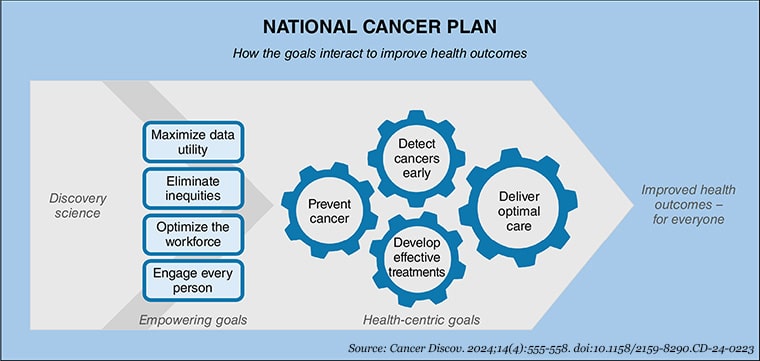
Still, the message to come out of both Rathmell’s address and the panel was the need for greater collaboration to achieve the goals of this plan and the Cancer Moonshot.
“If we are going to end cancer as we know it, we need to realize that we need to unify our forces, our troops, our teams,” LoRusso said. “Partnerships working together tend to have a greater impact on discoveries than most individuals working alone.”


